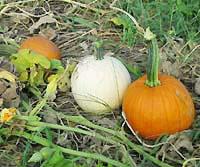UK Weed Research Aids Pumpkin Growers
UK Weed Research Aids Pumpkin Growers

 The bright orange pumpkin is a popular accent for autumn and Halloween decorating, and Kentucky pumpkin producers are working hard to accommodate the growing demand.
The bright orange pumpkin is a popular accent for autumn and Halloween decorating, and Kentucky pumpkin producers are working hard to accommodate the growing demand.
As with many Kentucky crops, weed control in pumpkins presents an ongoing management problem challenging grower efforts to meet consumer demand. Weeds compete for water and sun and they are also host to insects and diseases that can damage the pumpkin. At the University of Kentucky College of Agriculture Research and Education Center, research is under way to help growers with this task.
Joe Masabni, Extension fruit and vegetable specialist, said pumpkin and vegetables in general don’t have a lot of herbicide options for weed control. To assist growers in finding other options, Masabni is about to harvest his second pumpkin crop from a no-till pumpkin experiment evaluating 10 different herbicide treatments on two pumpkin varieties.
In the plots, wheat was seeded in the fall, killed in the spring and pumpkins planted then herbicides applied. Masabni said growers would typically spray before planting but with this research plot he is interested in trying a different approach. Of the 10 treatments, herbicides used in two currently are registered and labeled for pumpkins in Kentucky. The others are herbicides available on the market but not currently labeled for pumpkins. Different herbicide combinations and different rates were also used.
“We will harvest and take numbers of fruits and weights and see which ones did well and which did poorly,” he said. “Some plots look weedy, but have lots of fruit in them, some look clean but don’t have much fruits. Just because it looks clean, doesn’t mean herbicides worked because there’s a lot of injury that we haven’t measured yet.”
The two varieties selected for the tests are medium to small in size – Cotton Candy and Hybrid Pam.
“There seems to be more interest in medium to small pumpkins so kids can carry them when they go on school tours, so I used a couple of varieties that range between 6 and 10 pounds, although dry weather has made them even smaller this year.” Masabni said.
With 1,000 acres of pumpkins being grown in the state, Masabni said, he plans to continue the research for another year. Information gleaned from the study will be shared with chemical companies along with an organization that supports registration of pesticides for minor crops. If they have good data from UK and other locations, companies may be persuaded to add pumpkins to their label.
The ultimate goal is for farmers to have more options available. In Kentucky 10 herbicides are labeled for pumpkins, if one or two are lost, that’s 10 percent to 20 percent of their arsenal, he said. With current trends, that could happen at anytime.
Joe Williams, Extension associate for fruits and vegetables, assists Masabni in his research efforts and also works with a group of growers with their demonstration plots. This year he had one cooperator growing pumpkins, and next year Williams is planning to do some evaluations of different pumpkin production methods.
“Most pumpkins are grown on dry ground without irrigation,” he said. “There’s been interest in no-till and plasticulture, but there hasn’t been sufficient research comparing the yields in these different production methods.”
Williams plans to evaluate dry land production with and without irrigation, no-till and plasticulture.
Williams is also a producer, and he and his family have increased pumpkin production on their Caldwell County farm to five acres.
“So far, we haven’t reached the limit where we couldn’t sell them, which is why we’ve been expanding,” he said. “The most popular are the largest pumpkins. The white ones, such as Cotton Candy, are a good novelty to have to add selection. If someone comes, they may buy five regular and two white ones.
“Every year more and more people are fall decorating,” Williams said. “Ten years ago you’d see only a few, now it seems like nearly every yard has straw and pumpkins out there.”
He’s seen grower interest increase each year as well.
“Where I sell my pumpkins, there are new growers each year that I haven’t seen in previous years,” Williams said.
